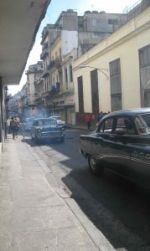After spending the last three weeks in Havana researching a book—and avoiding winter—I have reached a few modest conclusions.
First, there are things Haligonians could teach Habaneros.
About pooper scooper laws, for example. Havana’s sidewalks are a canine-created minefield. That becomes more understandable, of course, when you realize Havana has a shortage of plastic bags. But still…

A living, belching car museum.
Just as it understandable that—largely because of the 50-year-old U.S. trade embargo—Havana is a living, belching, vintage car museum. Still, Cuban lungs could benefit from a few North American-style exhaust emissions regulations.
And 21st century Canadians—for whom recycling is now routine—might be appalled at how casually Habaneros dispose of their disposables. People eat on the run, buying snacks from sidewalk vendors. When they’re done, they’re more likely to drop the remains than look for a waste bin. (That said, the nightly scouring of Havana’s streets and sidewalks is magical. By dawn, the city is pristine again—yesterday’s remnants swept into block-sized green bins and carted off—and ready for another day’s droppings.)
But Halifax could learn from Havana too.
Consider downtown redevelopment.
Though much of Havana still resembles a bombed-out city—there are daily reports of building collapses—the Cuban government is investing a huge chunk of tourism revenues in renewing its historic core.
The billion-dollar rebuilding of Havana Veija—the five-square-kilometre district founded in 1519—only began in earnest in 1993 after the collapse of the Soviet Union forced the country to turn to tourism.
But unlike most North American urban redevelopment schemes—in which history becomes tourist artifact and ordinary life is eliminated—the guiding philosophy behind Havana’s historic restoration has been that “the inhabitants become the beneficiaries.”

Esculia Primeria José Marti in session.
Wander through the pedestrians-rule side streets of Old Havana. Kids play soccer, dogs sleep where they please. Glance into open doorways. You’re as likely to see a family gathered around the TV as a souvenir shop. On Obispo, Havana’s main tourist artery, there’s a primary school. In lovingly restored Plaza Veija, there are trendy restaurants, even a popular micro-brewery. But if you look up, you’ll see a family’s laundry drying on a balcony.
During the restoration process, Plaza Vieja’s residents were relocated to other apartments. But as soon as the work was completed, they were allowed to return—only to much improved accommodation.
In Halifax, when we renewed our historic core, we pushed traditional residents out of the inner city—and, in the process, sucked the life out of downtown.
Havana has seemingly found a balance between its history and life.
Halifax should take something from that.
Oh yes, and a little sunshine too.






 STEPHEN KIMBER, a Professor of Journalism at the University of King's College in Halifax and co-founder of its MFA in Creative Nonfiction Program, is an award-winning writer, editor and broadcaster. He is the author of two novels and eight non-fiction books. Buy his books
STEPHEN KIMBER, a Professor of Journalism at the University of King's College in Halifax and co-founder of its MFA in Creative Nonfiction Program, is an award-winning writer, editor and broadcaster. He is the author of two novels and eight non-fiction books. Buy his books